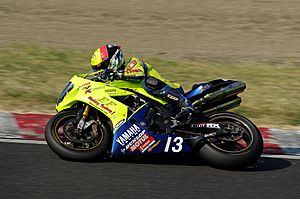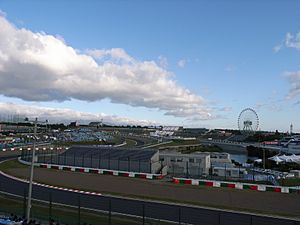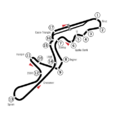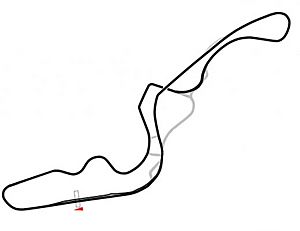Suzuka International Racing Course facts for kids
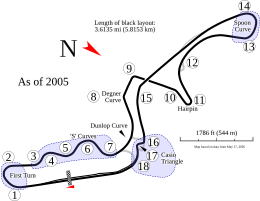 |
|
| Location | Suzuka, Mie Prefecture, Japan |
|---|---|
| Time zone | UTC+09:00 |
| Coordinates | 34°50′35″N 136°32′26″E / 34.84306°N 136.54056°E |
| Capacity | 155,000 |
| FIA Grade | 1 |
| Owner | Honda Motor Co., Ltd. |
| Operator | Honda Mobilityland |
| Opened | September 1962 |
| Architect | John Hugenholtz |
| Major events | Current: Formula One Japanese Grand Prix (1987–2006, 2009–2019, 2022–present) FIM EWC Suzuka 8 Hours (1978–2019, 2022–present) GT World Challenge Asia (2017–2019, 2022–present) Super GT (1993, 1995–present) Super Formula (1973–present) Former: Grand Prix motorcycle racing Japanese motorcycle Grand Prix (1987–1998, 2000–2003) WTCR Race of Japan (2011–2014, 2018–2019) Suzuka 10 Hours (1966–1973, 1980–2019) FIA GT (1997–1998) NASCAR Thunder Special Suzuka (1996–1997) World Sportscar Championship (1989–1992) |
| Grand Prix Circuit (2009–present) | |
| Length | 5.807 km (3.608 mi) |
| Turns | 18 |
| Race lap record | 1:30.983 ( |
| Motorcycle Grand Prix Circuit (2004–present) | |
| Length | 5.821 km (3.617 mi) |
| Turns | 17 |
| Race lap record | 2:06.805 ( |
| Grand Prix Circuit (2003–2008) | |
| Length | 5.821 km (3.608 mi) |
| Turns | 18 |
| Race lap record | 1:31.540 ( |
| East Circuit (1983–present) | |
| Length | 2.243 km (1.394 mi) |
| Turns | 7 |
| Race lap record | 0:48.245 ( |
| West Circuit (2009–present) | |
| Length | 3.466 km (2.154 mi) |
| Turns | 9 |
| Motorcycle Grand Prix Circuit (2003) | |
| Length | 5.824 km (3.619 mi) |
| Turns | 17 |
| Race lap record | 2:04.970 ( |
| Grand Prix Circuit (1987–2002) | |
| Length | 5.860 km (3.641 mi) |
| Turns | 18 |
| Race lap record | 1:36.125 ( |
| West Shortcut Circuit (1987–2002) | |
| Length | 2.780 km (1.728 mi) |
| Turns | 9 |
| Race lap record | 0:58.396 ( |
| Grand Prix Circuit (1983–1986) | |
| Length | 5.945 km (3.694 mi) |
| Turns | 17 |
| Race lap record | 1:54.400 ( |
The Suzuka International Racing Course (鈴鹿国際レーシングコース, Suzuka Kokusai Rēsingu Kōsu), more famously known as the Suzuka Circuit (鈴鹿サーキット, Suzuka Sākitto), is a 5.807 km (3.608 mi) long motorsport race track located in Ino, Suzuka City, Mie Prefecture, Japan and operated by Honda Mobilityland, a subsidiary of Honda Motor Co, Ltd. It has a capacity of 155,000.
Contents
Introduction
Soichiro Honda decided to develop a new permanent circuit in Mie prefecture in the late 1950s. Designed as a Honda test track in 1962 by Dutchman John "Hans" Hugenholtz, the most iconic feature of the track is its "figure eight" layout, with the 1.2 km (0.75 mi) long back straight passing over the front section by means of an overpass. It is one of only two FIA Grade 1 licensed tracks to have a "figure eight" layout, the other one being the Fiorano Circuit.
The circuit has been modified at least eight times:
In 1983 a chicane was inserted at the last curve to slow the cars into the pit straight; the original circuit was an incredibly fast track with only one slow corner; without the Casio chicane some cars would go through the final long right-hand corner flat out and then would go past the pits at more than 200 mph (320 km/h). In 1984 the first part of Spoon was made slightly slower and the corner was brought closer to the track to expand run-off area there, and in 1985 the first corner was made slightly slower.
In 1987 the circuit was brought up to F1 and Grand Prix motorcycle standards for both Japanese Grand Prixs of their respective championships, the F1 Grand Prix being the first held at Suzuka. The Degner curve was made into two corners instead of one long curve, and more crash barriers, more run-off areas were added, exposed vegetation was barricaded off and straw bales were removed (but still used for the Japanese motorcycle Grand Prix).
In 2002, the chicane was slightly modified, 130R (marked as 15 on the diagram) was also modified and some of the snake curves were made a bit straighter and faster; additionally, the runoff area at the Dunlop Curve was doubled from 12 metres to 25 metres, and the corner itself was made slightly tighter.
In 2003, the chicane was made slightly faster and closer to the 130R.
Following the death of Daijiro Kato at the 2003 Japanese motorcycle Grand Prix, Suzuka reconfigured the motorcycle variant of what is now known as the Hitachi Automotive Systems Chicane before the final turn, and added a second chicane, between the hairpin and 200R.
The circuit can be used in five configurations; the car full circuit, the motorcycle full circuit, the "Suzuka east," "Suzuka west car," and "Suzuka west motorcycle" configurations. The "east" portion of the course consists of the pit straight to the first half of the Dunlop curve (turn seven), before leading back to the pit straight via a tight right-hander. The "west" course is made up of the other part of the full circuit, including the crossover bridge; the straight leading to the overpass is used for the start/finish line and the grid. The chicane between the hairpin and 200R separates the west and full course sections between cars and motorcycles.
The Degner curve was named in honour of Ernst Degner after he crashed his factory Suzuki 50 there during Suzuka's inaugural All Japan Championship Road Race meeting on 3 November 1962.
The hairpin (turn 11) was coined 'Kobayashi Corner' after Japanese driver Kamui Kobayashi passed five drivers with aggressive moves at the 2010 Japanese Grand Prix.
At the 2014 Japanese Grand Prix, F1 driver Jules Bianchi suffered serious injuries after colliding with a recovery vehicle, and died in hospital as a result nine months later. In the wake of the accident, the Dunlop corner was slightly changed and revised in safety standards, and the organisers of the Japanese Grand Prix installed a large crane in place of the tractor that Bianchi hit.
Motorsport events
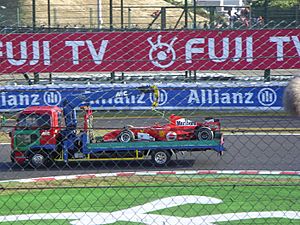
Suzuka, openly touted by F1 drivers and fans as one of the most enjoyed, is also one of the oldest remaining tracks of the Formula One World Championship, and has a long history of races as venue of the Japanese Grand Prix since 1987. Its traditional role as one of the last Grands Prix of the season means numerous world championships have been decided at the track. Four years consecutively in its early history the circuit saw the world championship decided. These include the 1988 championship, which went to Ayrton Senna, the controversial 1989 championship, which went to Alain Prost, and the 1990 and 1991 world championships, which both went to Senna.
Suzuka was dropped from the Formula One calendar for the 2007 and 2008 seasons in favour of the Toyota-owned Fuji Speedway, after the latter underwent a transformation and redesign by circuit designer Hermann Tilke. Suzuka and Fuji were to alternate hosting the Japanese Grand Prix from 2009. However, after Fuji announced in July 2009 that it would no longer be part of the F1 calendar, Suzuka signed a deal to host the Japanese Grand Prix in 2009, 2010 and 2011.
The circuit closed for a year for renovations to make it F1-compliant for 2009, with the last major event held on November 18, 2007, although some annual events (for instance, the Suzuka 8 Hours and Suzuka 1000km) were still held. The track held a re-opening day on April 12, 2009.
Suzuka also hosts other motorsport events including the Suzuka 1000 km endurance race. Previously a part of multiple GT racing series including the now defunct group C class of the All Japan Sports Prototype Championship, the Suzuka 1000 km as of 2006 is now a points round of the Super GT Series, and is the only race of such length in that series. In 2010, the GT500 pole position time was 1:55.237. In 2007, the GT300 pole position time was 2:06.838.
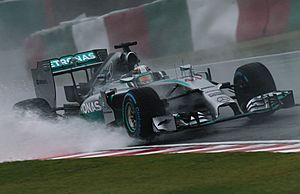
Another major motorsport event is the Suzuka 8 Hours for motorcycles, which has been run since 1978. This event usually attracts big name riders and with the exception of 2005, due to the importance of the major manufacturers' involvement, the FIM ensures that no motorcycle races clash on the date.
NASCAR organized the NASCAR Thunder 100, a pair of exhibition 100-lap races on the east circuit, a 1.4 mi (2.3 km) layout which utilizes the pit straight and esses, before rejoining the main circuit near the Casio triangle. The cars were Sprint Cup Series and Camping World West Series cars and the field was by invitation for the two races, run after the 1996 and 1997 seasons. The 1996 event was marred by tragedy when during practice, pace car driver Elmo Langley died of a heart attack in the Chevrolet Corvette pace car at the esses during an evaluation run. The pole position speed was 83.079 mph (133.703 km/h). During qualifying for the 1997 race, rain caused Goodyear to use rain tires on Winston Cup cars for the first time in the modern era.
It was announced on June 21, 2010, that the east section of the Suzuka Circuit would host the Japan round of the 2011 WTCC season instead of the Okayama International Circuit. At the 2012 event, the pole position time was 52.885 seconds, for an average speed of 94.875 mph (152.687 km/h).
130R corner
Following two major accidents in 2002 and 2003, one of the main issues in safety has been at the corner 130R (marked 15 in the track map above). In 2002, Toyota F1 driver Allan McNish suffered a high-speed crash through the bump, which sent him through a metal fence; he was not seriously injured.
Track officials revised the 130R, redesigning it as a double-apex section, one with an 85 m (93 yd) radius, and then a second featuring a 340 m (370 yd) radius, leading to a much closer Casio triangle (chicane), with the chicane becoming a "bus stop" type for motorcycles.
However, the problem continued for the new revised section. During the 2003 MotoGP Grand Prix of Japan, the track's first major event since the revisions, MotoGP rider Daijiro Kato was killed when he crashed in the new section, on his way to the braking zone for the Casio triangle. MotoGP has not returned to Suzuka since the incident.
Track configurations
Events
- Current
- March: Super Taikyu
- April: Super Formula Championship, MFJ Superbike
- May: Formula Regional Japanese Championship, TCR Japan Touring Car Series
- June: Super GT, F4 Japanese Championship
- July: GT World Challenge Asia Fanatec Japan Cup, Ferrari Challenge Japan, GT4 Asia Series, Porsche Carrera Cup Asia, Super Formula Lights
- August: FIM Endurance World Championship Suzuka 8 Hours, Super GT, F4 Japanese Championship
- September: Formula One Japanese Grand Prix
- October: Super Formula Championship, MFJ Superbike MFJ Grand Prix, Super Taikyu
- Former
- Asia Road Racing Championship (2013–2019)
- BPR Global GT Series 1000km of Suzuka (1994–1996)
- F3 Asian Championship (2019)
- FIA GT Championship (1997–1998)
- Grand Prix motorcycle racing Japanese motorcycle Grand Prix (1987–1998, 2000–2003)
- IDCR (1978–2003)
- Intercontinental GT Challenge Suzuka 10 Hours (2018–2019)
- International Touring Car Championship (1996)
- NASCAR Thunder Special Suzuka (1996–1997)
- World Sportscar Championship (1989–1992)
- World Touring Car Championship FIA WTCC Race of Japan (2011–2014)
- World Touring Car Cup FIA WTCR Race of Japan (2018–2019)
Lap records
The official lap record for the current circuit layout is 1:30.983, set by Lewis Hamilton during the 2019 Japanese Grand Prix. Previously, the record was set in 2005 by Kimi Räikkönen with a time of 1:31.540 (albeit on a marginally longer, slightly different variation of the circuit). The unofficial all-time track record is 1:27.064, set by Sebastian Vettel during final qualifying for the aforementioned 2019 race.
As of July 2023, the fastest official race lap records at the Suzuka Circuit are listed as:
| Category | Time | Driver | Vehicle | Event |
|---|---|---|---|---|
| Grand Prix Circuit: 5.807 km (2009–present) | ||||
| Formula One | 1:30.983 | Lewis Hamilton | Mercedes AMG F1 W10 EQ Power+ | 2019 Japanese Grand Prix |
| Super Formula | 1:37.850 | Naoki Yamamoto | Dallara SF19 | 2020 1st Suzuka Super Formula Championship round |
| Formula Nippon | 1:42.781 | João Paulo de Oliveira | Swift FN09 | 2012 2nd Suzuka Formula Nippon round |
| Super GT (GT500) | 1:48.055 | Mitsunori Takaboshi | Nissan Fairlady Z GT500 | 2022 Suzuka Super GT round |
| Super Formula Lights | 1:50.714 | Ritomo Miyata | Dallara 320 | 2020 Suzuka Super Formula Lights round |
| Formula 3 | 1:52.116 | Mitsunori Takaboshi | Dallara F312 | 2017 1st Suzuka Japanese F3 round |
| Formula Regional | 1:58.776 | Sota Ogawa | Dome F111/3 | 2021 Suzuka FRJC round |
| Super GT (GT300) | 1:59.252 | Morio Nitta | Lexus RC F GT3 | 2018 Suzuka Super GT round |
| GT3 | 2:02.221 | Andy Soucek | Bentley Continental GT3 | 2019 Suzuka 10 Hours |
| Lamborghini Super Trofeo | 2:03.171 | Ben Gersekowski | Lamborghini Huracán Super Trofeo | 2018 Suzuka Lamborghini Super Trofeo Asia round |
| GT2 | 2:06.738 | Mitsuhiro Kinoshita | Porsche 911 (997) GT3 RSR | 2009 300 km of Suzuka |
| Formula 4 | 2:08.297 | Rin Arakawa | Dome F110 | 2020 Suzuka Japanese F4 round |
| TC1 | 2:09.063 | Gabriele Tarquini | Honda Civic WTCC | 2014 FIA WTCC Race of Japan |
| Ferrari Challenge | 2:09.492 | Nobuhiro Imada | Ferrari 488 Challenge Evo | 2023 Suzuka Ferrari Challenge Japan round |
| TCR Touring Car | 2:11.509 | Takuro Shinohara | Audi RS 3 LMS TCR | 2020 Suzuka TCR Japan round |
| Super 2000 | 2:14.392 | Franz Engstler | BMW 320 TC | 2014 FIA WTCC Race of Japan |
| GT4 | 2:14.634 | Shinya Hosokawa | Mercedes-AMG GT4 | 2022 MOTUL Japan Cup Series of Suzuka |
| Motorcycle Grand Prix Circuit: 5.821 km (2004–present) | ||||
| FIM EWC | 2:06.805 | Jonathan Rea | Kawasaki ZX-10R | 2019 Suzuka 8 Hours |
| AJRRC | 2:07.110 | Kousuke Akiyoshi | Honda CBR1000RR | 2009 All Japan Road Race Championship, Round 2 |
| Asia Supersports 600 | 2:12.508 | Dimas Ekky Pratama | Honda CBR600RR | 2016 Suzuka ARRC round |
| Asia Production 250 | 2:27.872 | Rheza Danica Ahrens | Honda CBR250RR | 2018 Suzuka ARRC round |
| Asia Underbone 150 | 2:37.852 | Gupita Kresna | Yamaha T-150 | 2019 Suzuka ARRC round |
| Grand Prix Circuit: 5.821 km (2003–2008) | ||||
| Formula One | 1:31.540 | Kimi Räikkönen | McLaren MP4-20 | 2005 Japanese Grand Prix |
| Formula Nippon | 1:44.948 | Yuji Tachikawa | Lola FN06 | 2008 Suzuka Formula Nippon round |
| Super GT (GT500) | 1:53.118 | Ralph Firman | Honda NSX-GT | 2007 1st Suzuka Super GT round |
| Formula 3 | 1:55.515 | Kazuya Oshima | Dallara F306 | 2007 1st Suzuka Japanese F3 round |
| Super GT (GT300) | 2:05.124 | Kazuya Oshima | Toyota MR-S | 2007 1st Suzuka Super GT round |
| Formula Toyota | 2:07.387 | Hideto Yasuoka | Tom's FT30 | 2004 1st Suzuka Formula Toyota round |
| East Circuit: 2.243 km (1983–present) | ||||
| Formula 3 | 0:48.245 | Toshihiro Kaneishi | Dallara F399 | 1999 3rd Suzuka Japanese F3 round |
| Formula Toyota | 0:51.049 | Hideto Yasuoka | Tom's FT30 | 2004 2nd Suzuka Formula Toyota round |
| Super 2000 | 0:53.885 | Alain Menu | Chevrolet Cruze 1.6T | 2012 FIA WTCC Race of Japan |
| TCR Touring Car | 0:53.888 | Norbert Michelisz | Hyundai i30 N TCR | 2019 WTCR Race of Japan |
| Stock car racing | 1:02.279 | Mark Martin | Ford Thunderbird | 1997 NASCAR Thunder Special Suzuka |
| Motorcycle Grand Prix Circuit: 5.824 km (2003) | ||||
| MotoGP | 2:04.970 | Valentino Rossi | Honda RC211V | 2003 Japanese motorcycle Grand Prix |
| 250cc | 2:09.839 | Hiroshi Aoyama | Honda NSR250 | 2003 Japanese motorcycle Grand Prix |
| 125cc | 2:14.282 | Stefano Perugini | Aprilia RS125R | 2003 Japanese motorcycle Grand Prix |
| Grand Prix Circuit: 5.860 km (1987–2002) | ||||
| Formula One | 1:36.125 | Michael Schumacher | Ferrari F2002 | 2002 Japanese Grand Prix |
| F3000 | 1:44.258 | Toshio Suzuki | Lola T95/50 | 1995 Suzuka Japanese F3000 round |
| Formula Nippon | 1:46.278 | Michael Krumm | Reynard 95D | 1996 Suzuka Formula Nippon round |
| Group C | 1:49.148 | Derek Warwick | Jaguar XJR-14 | 1991 430 km of Suzuka |
| LMP900 | 1:54.168 | Seiji Ara | Audi R8 | 2002 Suzuka 1000km |
| Group C2 | 1:54.899 | Mauro Martini | Nissan R91CK | 1992 1000 km of Suzuka |
| IMSA GTP | 1:55.474 | Mauro Martini | Nissan R93CK | 1993 1000 km of Suzuka |
| GT1 (Prototype) | 1:56.416 | Allan McNish | Porsche 911 GT1-98 | 1998 Suzuka 1000km |
| Prototype | 1:58.512 | Geoff Lees | Reynard 89DGC | 1989 Suzuka 200km |
| JGTC (GT500) | 1:58.531 | Ralph Firman | Honda NSX-GT | 2002 Suzuka GT 300 km |
| Formula 3 | 1:59.888 | Shinya Sato | Dallara F302 | 2002 1st Suzuka Japanese F3 round |
| GT1 | 2:03.684 | Jean-Marc Gounon | Ferrari F40 GTE | 1996 1000 km of Suzuka |
| Class 1 Touring Cars | 2:03.886 | Bernd Schneider | AMG Mercedes-Benz C-Klasse | 1996 ITC Suzuka round |
| FIA Cup | 2:06.641 | Ferdinand de Lesseps | Spice SE89C | 1992 1000 km of Suzuka |
| 500cc | 2:06.746 | Max Biaggi | Honda NSR500 | 1998 Japanese motorcycle Grand Prix |
| WSC | 2:07.116 | Franck Fréon | Kudzu DG-3 | 1995 1000 km of Suzuka |
| JGTC | 2:07.322 | Aguri Suzuki | Nissan Skyline GT-R (BCNR33) | 1997 300 km Suzuka |
| GT1 (GTS) | 2:07.876 | Julian Bailey | Lister Storm | 2000 1000 km of Suzuka |
| 250cc | 2:08.581 | Shinya Nakano | Honda NSR250 | 2000 Japanese motorcycle Grand Prix |
| JGTC (GT300) | 2:09.060 | Yasutaka Hinoi | Mosler MT900R | 2002 Suzuka GT 300 km |
| Formula Toyota | 2:09.200 | Masato Shimoyama | Tom's FT20 | 2001 Suzuka Formula Toyota round |
| GT2 | 2:13.558 | Eiji Yamada | Chrysler Viper GTS-R | 2000 300 km of Suzuka |
| GT | 2:14.517 | Romain Dumas | Porsche 911 (996) GT3-RS | 2002 1000 km of Suzuka |
| 125cc | 2:15.353 | Masao Azuma | Honda RS125R | 2001 Japanese motorcycle Grand Prix |
| IMSA GTS | 2:16.068 | Bob Sobey | Ford Mustang GT | 1993 1000 km of Suzuka |
| Group A | 2:16.177 | Masahiro Hasemi | Nissan Skyline GT-R (BNR32) | 1991 Suzuka JTCC round |
| MotoGP | 2:19.105 | Valentino Rossi | Honda RC211V | 2002 Japanese motorcycle Grand Prix |
| IMSA GTU | 2:20.848 | Eduardo Dibos | Mazda RX-7 GTU | 1993 1000 km of Suzuka |
| Group B | 2:22.853 | Akihiko Nakaya | Porsche 911 (964) Carrera RSR 3.8 | 1993 1000 km of Suzuka |
| Group N1 | 2:31.803 | Masami Miyoshi | Nissan Skyline GT-R (BNR32) | 1993 1000 km of Suzuka |
| West Shortcut Circuit: 2.780 km (1987–2002) | ||||
| Formula Nippon | 0:58.396 | Toranosuke Takagi | Reynard 2KL | 2000 2nd Suzuka Formula Nippon round |
| Formula 3 | 1:03.635 | Paolo Montin | Dallara F301 | 2001 2nd Suzuka Japanese F3 round |
| Grand Prix Circuit: 5.945 km (1983–1986) | ||||
| Formula 2 | 1:54.400 | Stefan Johansson | March 842 | 1984 JAF Grand Prix |
| Group C | 1:56.486 | Kazuyoshi Hoshino | Nissan R86V | 1986 International Suzuka 1000 km |
| Superbikes | 2:18.923 | Wayne Gardner | Honda RVF750 | 1986 Suzuka 8 Hours |
| Original Grand Prix Circuit without Final Chicane: 6.004 km (1962–1982) | ||||
| Formula 2 | 1:52.990 | Kazuyoshi Hoshino Teo Fabi |
March 802 | 1980 JAF Grand Prix 1981 1st Suzuka Japanese F2 round |
| Formula 3 | 1:54.247 | Aguri Suzuki | Ralt RT3 | 1982 Suzuka Japanese F3 round |
| Group 5 (Sports Car) | 2:01.160 | Fumiyasu Sato | March 73S | 1979 Suzuka 500 mile |
| Group 4 | 2:08.040 | Fumiyasu Sato | BMW M1 | 1982 Suzuka 1000km |
| Superbikes | 2:14.760 | Wayne Gardner | Moriwaki Kawasaki Monster | 1981 4th Suzuka 8 Hours Endurance Race |
| Group 6 | 2:31.000 | Kuniomi Nagamatsu | Porsche 908 | 1970 300 km of Suzuka |
| Group 1 | 2:59.400 | Goro Urushiyama | Honda S600 | 1965 2nd Suzuka Clubman Race Meeting |
In video games
Along with Fuji Speedway, the Suzuka Circuit was one of the four tracks featured in the video game Pole Position II. The track is referred to in the Namco Museum versions of the game as the "Wonder Circuit" ("Orange Circuit" in Namco Museum: Virtual Arcade), after Namco's "Wonder" series of amusement parks, despite its logo appearing on the starter's box since 1983.
The Suzuka Circuit is also featured in the Final Lap series of games which first appeared in 1987. Another Namco racing game, Suzuka 8 Hours, based on the motorcycle race of the same name was released for arcades in 1992, followed by a port for the Super NES in 1993. It can also be seen in arcade games and video games such as Ferrari F355 Challenge, Super Monaco GP, Forza series, Gran Turismo series, RaceRoom, iRacing, R: Racing Evolution, Shift 2 Unleashed, Le Mans 24 Hours, The Cycles, MotoGP 3 of PlayStation 2, MotoGP 4, Tourist Trophy, Auto Modellista, Racing Battle: C1 Grand Prix, Real Racing 3, and as the final race in Taito's racing game Continental Circus. The east course was featured in NASCAR 98. Suzuka's Ferris wheel was paid homage in the "Big Forest Track" in Virtua Racing. A mod for Mario Kart Wii, CTGP Revolution, exists that adds the track.
Project CARS and Project CARS 2 have a Japanese circuit inspired by Suzuka, called Sakitto Circuit. Sakitto has numerous visual differences from the original Suzuka, including the change of position of the Ferris wheel near to Degner curves, as well as the absence of the Casio triangle and the hairpin, a very modified esses section, and a road pass through the real life location of the Ferris wheel.
Deaths
See also
 In Spanish: Circuito de Suzuka para niños
In Spanish: Circuito de Suzuka para niños
- Twin Ring Motegi, another Honda-owned race track and oval, host to the FIM MotoGP Japanese Grand Prix



